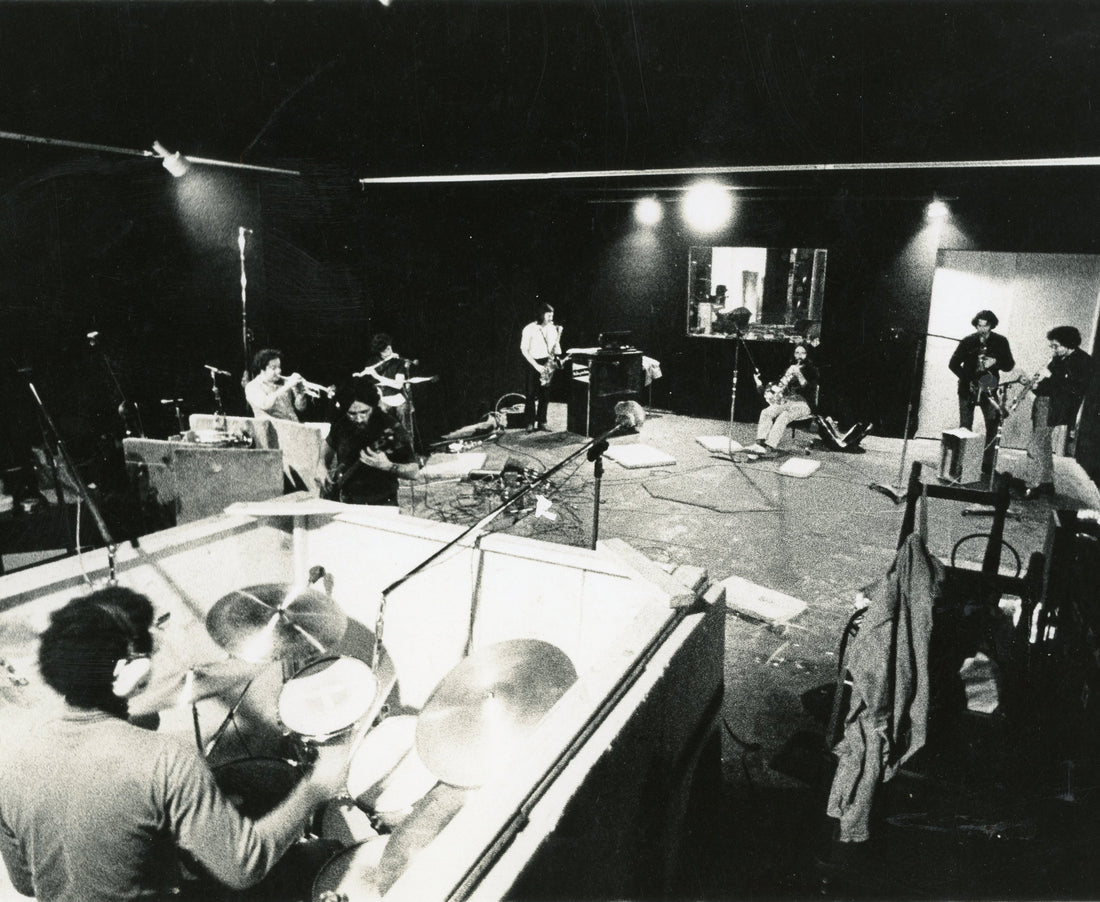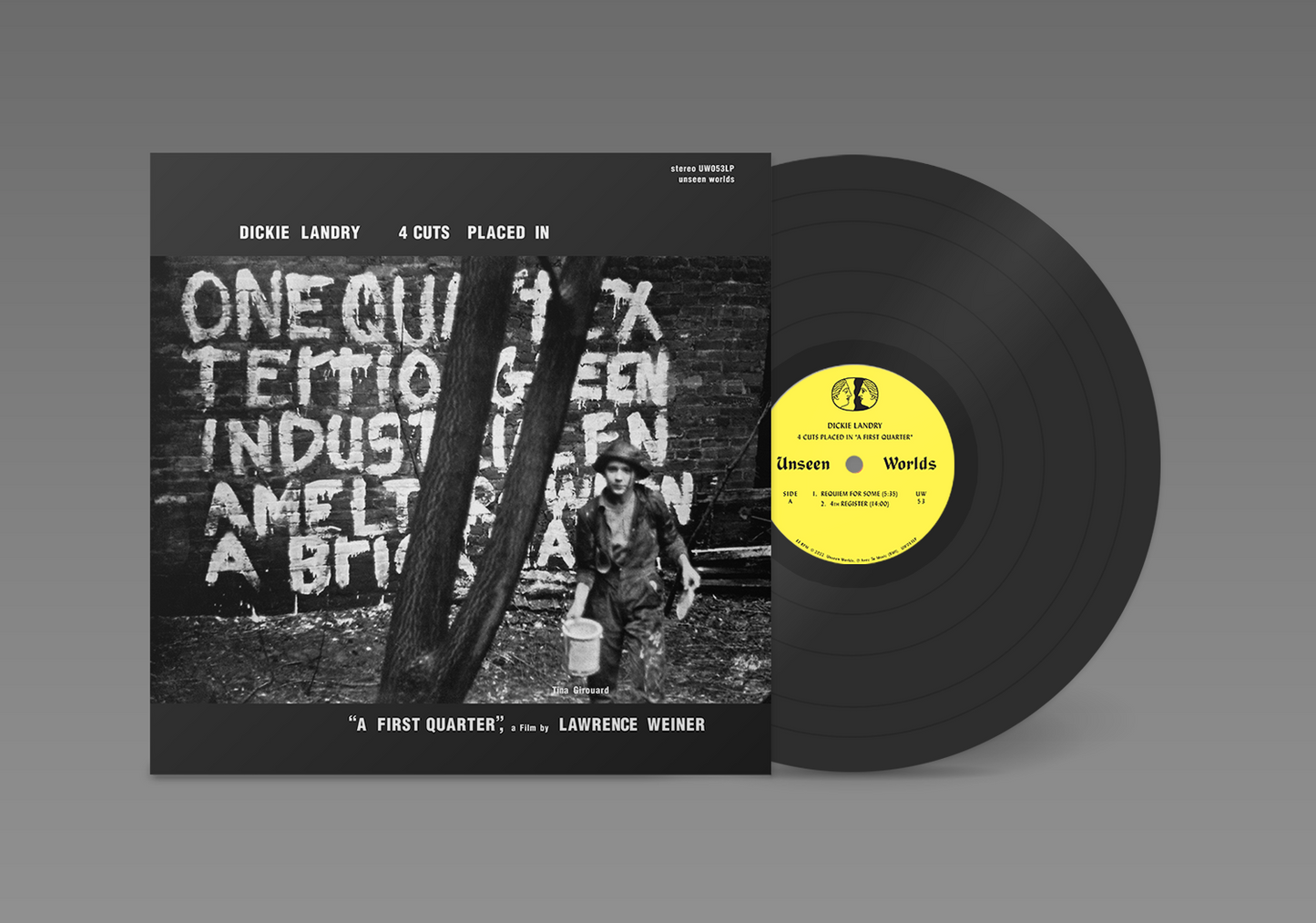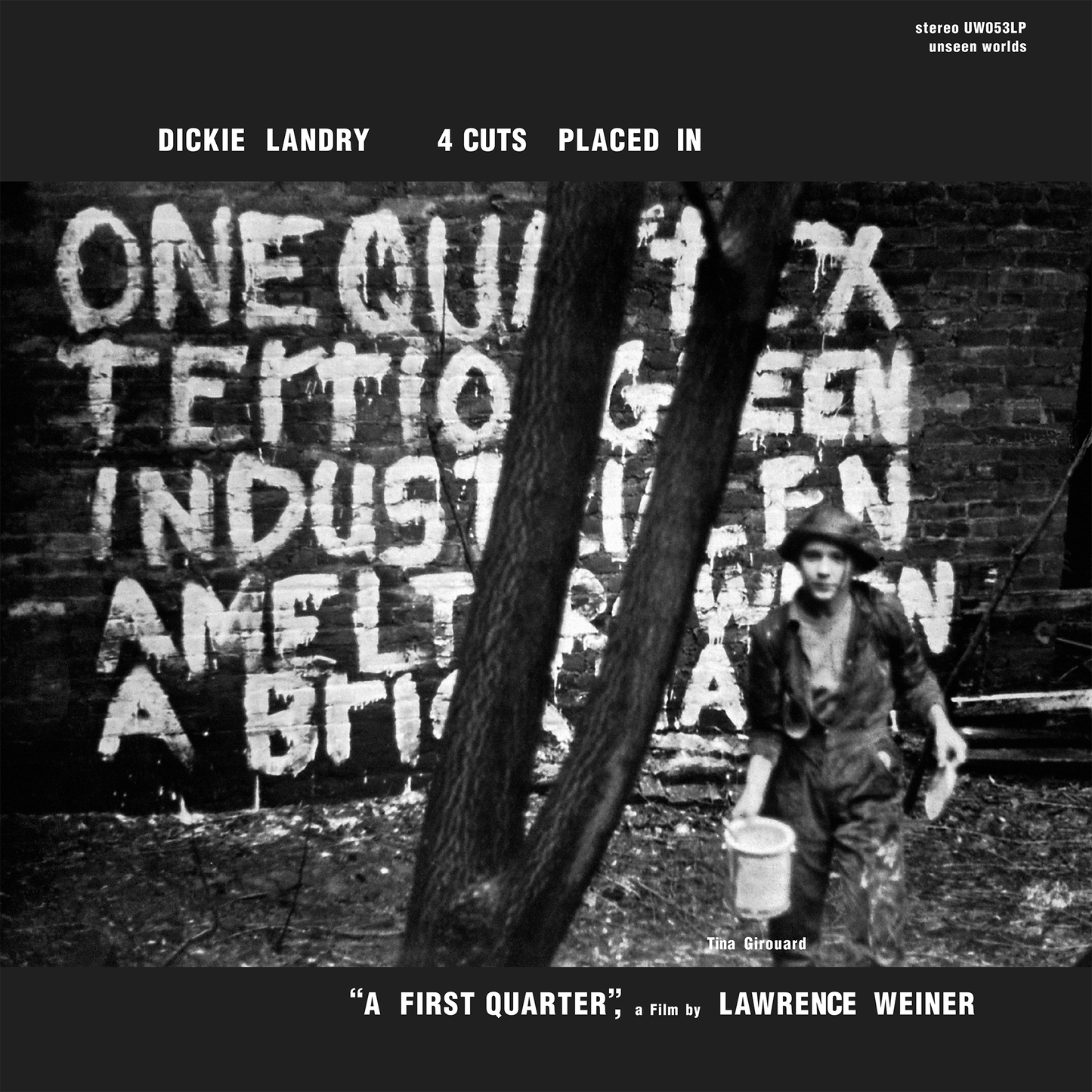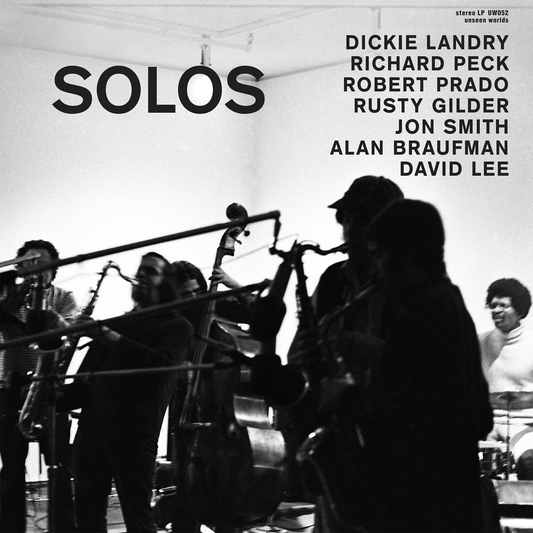Woodwind multi-instrumentalist Richard “Dickie” Landry (b. 1938, Cecilia, Louisiana) is an inveterate collaborator. Across a wide variety of music ranging from swamp pop to free improvisation, contemporary ‘minimalism’ to art rock, Landry has worked with seemingly every major figure in postwar American sound. Known for his twelve-year tenure in the Philip Glass Ensemble, Landry’s creative arsenal has been united with Laurie Anderson, the Talking Heads, Bob Dylan, David “Fathead” Newman, Paul Simon, and Warren Storm. There’s something gutsy and honest about his approach to playing and living, straightforward and from the soil. As directly connected to the New York avant-garde as Landry is, that factual drawl is always at the base of his participation. Perhaps that’s why he is something of an “artist’s saxophonist,” lending playful clarity to the theater works and installations of Robert Wilson, creating electronic music for the opening of the Menil Collection in Houston, or blowing alto solos amidst Robert Rauschenberg’s paintings for the artist’s Overseas Cultural Interchange.
When Landry moved to New York in 1969, working within the burgeoning downtown art scene was a near-immediate occurrence. Spurred on by Keith Sonnier, the post-minimal visionary from western Louisiana, Landry connected with Richard Serra, Nancy Graves, Gordon Matta-Clark, Lawrence Weiner, Mary Heilmann, and others whose careers and impact were just beginning to take shape. Through befriending these artists, Landry installed work at the Leo Castelli Gallery on West Broadway, developing an especially close relationship with Serra, with whom he collaborated on the lead “prop” pieces. Landry photographed artists as they blended work and life, buoyed by the crackling energy of 1970s Lower Manhattan. As he noted in a 2010 interview I conducted for Paris Transatlantic Magazine, “during this period I met Joan Jonas, a performance artist who invited me to her first performance. I borrowed a camera and took pictures. The next day she called me and said, ‘I saw you there last night with a camera, do you want to sell the photos?’ The light bulb went off! Of course I did––this is how I began my photographic journey. For the next ten years, I photographed all my friends in the art/dance/theatre and music world of SoHo at that time.”
Another of Landry’s enduring collaborations was with Lawrence Weiner (b. 1942, The Bronx; d. 2021, Manhattan), an artist whose work occupies text, sound, video, paper, paint, and idea. Weiner’s history as a working artist is mostly intertwined with the field of conceptual art, like minimalism a term that most of its practitioners rightly decry. The physicality of language, layers of meaning and interplay, not to mention its position in critique and political action, are the building blocks of his art. Weiner and Landry began collaborating through a generous and collegial network. Landry was the camera operator documenting hands moving a pack of cigarettes in two early video works, To and Fro. Fro and To. And To and Fro. And Fro and To (1972) and Shifted from the Side (1972). Weiner would soon involve him in A First Quarter, a feature-length video for four actors that was shot in Manhattan and Brooklyn in late 1973. As Landry remembers, “I was working for Keith Sonnier at Castelli Gallery and met Lawrence. Since I was doing video for Keith, he asked ‘can you make a video for me?’ So we did a little video called To and Fro… and that’s how we became friends. At some point he was working on A First Quarter and wanted me to do the music. I said ‘I already have the music.’ He said ‘what do you mean?’ I had recorded several pieces with [Philip Glass’ sound engineer] Kurt Munkcasi and walked around the set playing the music on a boom box.”
4 Cuts Placed In “A First Quarter,” A Film by Lawrence Weiner is the sonic result of this project. It features one solo each by Landry and contrabassist Rusty Gilder, a duo for the tenor saxophones of Landry and Richard Peck, and an ensemble piece for Landry, Peck, Gilder, trumpeter Robert Prado, and drummer David Lee, Jr.. A fifth cut was included in the film (solo alto flute) but does not appear on the record. Released by Chatham Square (LP 10), the label that Glass and Landry co-ran, 4 Cuts is a companion piece to Solos (Chatham Square LP 17), a double LP set recorded live at Castelli and featuring the above musicians plus saxophonists Jon Smith and Alan Braufman. Landry shot numerous stills during filming, and two of these adorn the cover of 4 Cuts. But A First Quarter was more than just an art film or an improvised music soundtrack. For Weiner it is a representation of the dialectic of wartime and peacetime vis-a-vis propositions delivered by individuals in familiar, detached settings, while for the participants camaraderie was created and sustained through the work and the social environment that gave rise to it. The script is entirely drawn from Weiner’s text pieces and publications (eg. Statements, 1968), enunciating material and process through alterations, displacement, destruction, and boundary-making vis-a-vis a political current: “a field cratered by structured simultaneous explosions,” “a series of stakes set in the ground at regular intervals to form a rectangle/twine strung from stake to stake to de-mark a grid,” or “ten pounds mercury tossed from Finland to Sweden.” The roles were filled by Mel Kendrick (b. 1949, Boston), Elaine Grove (b. 1943, Oklahoma City), and Bella Obermaier (b. 1948, Munich), and Landry brought his then-partner Tina Girouard (1946-2020, DeQuincy, Louisiana) into the project. Produced by Leo Castelli and Joyce Nereaux, A First Quarter was shot in the Rockaways, in a car on the way to (or from) the Rockaways, in a SoHo street, in a high-end Murray Hill apartment, and in Weiner’s backyard on Bleecker Street over a matter of days. In addition to providing music, Landry also reads some of the script off camera (in English and Cajun French) as well as reciting the credits.
A bit about the primary voices in A First Quarter: Kendrick is a sculptor and had been working for Dorothea Rockburne at the time. He met Weiner at the 1972 Venice Biennale and recalls that “Lawrence asked Dorothea if it was okay if he asked me [to be in the film]––and I immediately said ‘I’m not an actor’ and he said ‘oh no, I like the way you move.’” Elaine Grove, then an actor and visual artist, and Bella Obermaier (who retouched photos for Cecil Beaton in London and then pivoted to costume design) were both regulars at Max’s Kansas City. Grove recalls that Weiner initially had asked Helen Marden, then-wife of painter Brice Marden, who recommended her, and Grove invited Obermaier. Grove remembers that “it was interesting because as an actress you need to motivate or find the intention. You want something from the other character or you’re trying to achieve something, and Larry wanted the exact opposite of that, just flat––no emotion, just reading the script, and you don’t have to understand it. It was interesting and in a way discombobulating––it was anti-acting and one kept feeling the temptation to relate to the other actor or the situation.” The French New Wave or a specter of it is prevalent throughout; an undercurrent of youthfulness amid stark, grey settings pervades the arc of A First Quarter, interspersed with occasional slices of crowded vivacity and tactile temperature.
The film is a series of interconnected vignettes, separated by what theatre director and visual artist Robert Wilson would call a ‘knee play’ (a self-contained piece that is positioned like an interlude) at 41 minutes. The knee, which runs for nearly fifteen minutes, consists of Girouard in coveralls and a cap painting the following text on a wall behind Weiner’s Bleecker Street apartment: ONE QUART EXTERIOR GREEN INDUSTRIAL ENAMEL THROWN ON A BRICK WALL. Girouard deftly applies the paint, the words contained within a large rectangle, whistling as she works in the rain. Opening with a shot of military helicopters overhead, the remaining 70 minutes of footage consist of short to moderately long blocks that are sometimes repeated and recombined, with or without music and script: a beach and park walkabout; Grove and Kendrick making and hanging out in an upscale apartment (adorned by placards with Weiner’s text); Obermaier and Kendrick making out on the hood of his 1966 Volvo 122; the three driving and reciting; Obermaier and Grove in bed, awakened by a doorbell; the actors at a kitchen table smoking, speaking, and typing. Interspersed with the gauzy intensity of Landry’s music, there’s a dreamlike haze pervading these situations, abetted by the grainy video-to-film-to-video transfer, but the actors’ dynamic and the staging are also unfussy and matter-of-fact. For example, Grove gets dressed as Kendrick reads the paper and the women smoke while music weaves through the proceedings. Kendrick hacks away at a typewriter transcribing Grove’s recitation, his abrasive, mechanical staccato in high contrast with the natural, layered cadences of voices and Landry’s improvisation. As Weiner put it in a recent interview I conducted, “we were all impressed by the fact we were able to make something that had the ability to carry dignity with it. These films, surprisingly enough I think of them as home movies. They’re quite [full of] dignity in each of the performers. The camera does not intrude on them, the camera just portrays them, which is a hard thing to do as a young director.” That said, there are moments of levity as well: Obermaier reciting To and Fro. Fro and To. while laughing and tracing the lines of Kendrick’s chest as they kiss, or the nearly erotic when Grove and Kendrick fool around on the chaise lounge twenty minutes into the film. Of that, Grove remembered “I’m laying on a day bed with a script and Mel is sitting next to me, and I’ve got this little cast on my right index finger––just before filming I fell off my bike and broke it!”
But the music that Landry recorded and eventually released is of a parallel piece and has lived an independent life: released by Chatham Square, which had ample independent distribution, the soundtrack to 4 Cuts got around far more easily than the film’s occasional showings. Starting the record off is “Requiem for Some,” for which, as the saxophonist puts it, “my only instruction was long tones — nothing was written, and the first couple of takes people started improvising and going off but I had to tell them ‘no, loooong tooones.’ Gil Evans, that was my thought — long, placid tones.” The anchor is Lee’s dry cymbal attack and fancy footwork, dancing around overlapping and recombining horns, chords held just shy of splintering. It’s far from background music when divorced from its context, though even when coexisting with actors and text, instrumental sound acts as an off-kilter intervention and fills the space in a manner not altogether different from the sculptors Landry worked with at the time. “4th Register” is a grainy delayed solo tenor piece, lilting mechanics and a tune reminiscent of piping music, presaging the naked languidity of works like “Kitchen Solos” (Fifteen Saxophones, Northern Light 87003/UW 06) by several years. “Piece for So” was, according to Landry, “a chance to give Rusty a solo” and he more than acquits himself. Mostly known as an ensemble bassist, Gilder bounced between Lafayette, Charlotte, and New York, leaving a slim recorded legacy. Here, he stretches out for twelve minutes and change, overdubbed pizzicato and arco creating a hive of motion and energetic swing. With keen upper register detail and meaty up-tempo walk, he could have been mentioned in the same breath as players like Dave Holland and Barre Phillips. The closing “Duo Vivace” finds Landry and Peck sparring on tenors, the latter holding a melodic line while Landry leans into explosive glossolalia until both become birds in flight.
A First Quarter would be the only time that all four actors, Weiner, and Landry worked together on a project; Kendrick recalls that he was asked to participate in A Second Quarter, filmed in Berlin, but was unable due both to expense and his beginning trajectory as a sculptor. Upon the film’s premiere screening at the Castelli Gallery, Kendrick relates that “it put me into the art world in a very strange way. I remember sitting in the back room, and I smoked at that point. I had a pack of unfiltered Camels and I just kept smoking them. By the end of the film I was sort of nauseous! Mel Bochner was there, I imagine Richard Serra was there, Chuck [Close]… I was just the kid, you know. At that time, I wasn’t seen as the artist. I was just in this film, but it’s quite a thing to have on my resume.” Obermaier shortly thereafter returned to Munich, while Grove stayed in New York, worked as an actress and eventually began making sculptures from metal and found objects. Girouard, meanwhile, was a central figure in New York performance, co-running FOOD with Carol Godden and Gordon Matta-Clark before returning to Louisiana and focusing on art and community in her home state and in Haiti. Enlivened through a soundtrack and still photographs, 4 Cuts and A First Quarter both continue to breathe, a sonic and visual snapshot from a period in New York that is both quaint and full of possibility.
Clifford Allen
Brooklyn, NY
March 2021





![[product title] - unseen worlds](http://unseenworlds.com/cdn/shop/products/UW06CoverHiRes_533x.jpg?v=1566370081)

